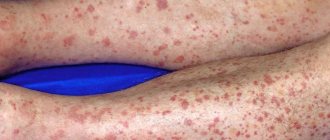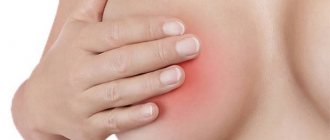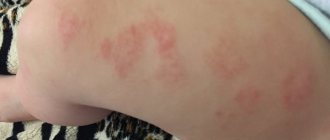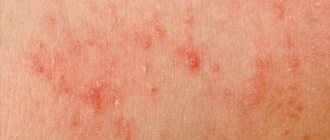The skin is a protective organ of a person, which not only performs its assigned functions, but also reflects the condition of the entire organism as a whole. Any changes in the condition of the skin may indicate the presence of negative external influences, or the development of serious diseases.
Red spots on the legs are pronounced changes in the color of the dermatological integument that appear in one area of the skin. The cause of the appearance of this defect on the limbs can be both cosmetics and pathological changes that occur inside the body.
If the disease is not treated, then after some time it will begin to slow down all metabolic processes and this will immediately affect the formation and functioning of pigment cells. If their work is disrupted sufficiently, unsightly spots begin to appear on the skin.
Red, rough spots on the legs: what to do?
Rough patches on the skin can result from atopic dermatitis.
- If you know for sure that the appearance of red spots was caused by cosmetics or detergents, then simply eliminate the source of irritation and use hygiene products without fragrances and dyes to care for your limbs for a couple of days
- If everything is in order with your body, then after 3-4 days the skin will return to its normal color and you will again be able to feel confident in public.
- But if the spots do not disappear, and their foci only increase in size, then you need to seek help from a specialist
- Usually such patients are offered to undergo venography and, of course, a complete examination of the whole body. If any pathology of internal organs is found, further treatment will be carried out comprehensively
- The doctor will select remedies that will help fight both one and the other pathologies at the same time. If for some reason you cannot quickly see a doctor, then try to alleviate your condition with antihistamines and ointments that have anti-inflammatory properties
Mycosis
Points for mycosis of the feet
A point symptom on the lower extremities in the form of a rash or other manifestations may indicate the progression of a mycotic disease. This happens if fungal bacteria have entered the body. Most often, such phenomena can be found on the feet or between the toes, because the skin is the most delicate there.
The primary symptoms will be approximately the following: the appearance of painful cracks, blisters, severe itching and diaper rash. The next stage will be peeling and peeling of the skin in large layers, and where there were previously blisters, ulcers form.
To prescribe the correct treatment, it is necessary to be examined by a doctor, and you will also need to take tests to identify the type of pathogen. The most well-known drugs for fighting fungus are: Miconazole, Econazole, Fukortsin, as well as Lamisil and Orungal tablets. But you should not treat the fungus yourself; it is very important that the drugs and their dosage are selected by a mycologist or dermatologist.
Pathological causes
Spots on the legs can appear for many reasons. By its appearance and accompanying symptoms, you can understand what caused the rash and how to treat it. Often the causes of the appearance of red dots are various diseases. [ads1]
Allergy
Allergies are one of the most common causes of spots on the legs and entire body. She may be:
- Food. This allergic reaction is associated with the consumption of allergenic foods. This could be nuts, honey, citrus fruits, dairy products, sweets, etc.
- Medication. An allergy to medications can be caused by the body's hypersensitivity to individual components of the drug, as well as by improper use or overdose. Most often, unpleasant symptoms, including the appearance of red spots on the legs, are associated with taking antibiotics, but other types of medications can also provoke a negative reaction.
- Contact. An allergic reaction is triggered by contact with an allergenic substance. These include cosmetics, unsuitable hygiene products, and contact with plant juice or pollen on the surface of the skin.
The most common types of allergies that cause red spots on the legs are atopic and contact dermatitis.
Eczema
Eczema is a skin disease in which red spots of varying sizes appear on the skin of the legs or other parts of the body. They are often dry, itchy, covered with a crust that flakes off. But sometimes ulcerations appear on the surface of the rash. In this case, the disease is called weeping eczema. [ads2]
The disease can develop against the background of frequent allergic reactions, as well as numerous pathologies of internal organs. The risk group includes diabetics, patients with weak immunity and HIV infection.
Psoriasis
Psoriasis develops when the body begins to actively produce skin cells, as a result of which there are more of them than necessary. The development of the disease can be the result of severe stress, injury, infectious diseases, taking certain types of medications, or bad habits. [ads3]
Psoriasis is an immune disease, the development of which is difficult to predict and prevent. Moreover, it cannot be completely cured - you can only relieve the symptoms and put the pathology into remission.
Folliculitis
Inflammation of the hair follicles is most often observed on the lower extremities. [ads4]
The disease affects mainly women, although it can also develop in men (in this case, not only on the legs). The main cause of folliculitis is mechanical damage to the skin. For example, while shaving.
Fungal infection
The fungus most often affects the toes, but can also develop on the feet and legs. The disease is very contagious and is easily transmitted through personal contact. Also, mycosis of the skin of the legs can develop after undergoing a course of treatment with powerful antibacterial drugs. [ads5]
Fungus of the lower extremities is a common occurrence in people with excessive sweating of the feet. Wearing underwear made from synthetic materials can also cause this disease. The skin becomes irritated under the influence of unnatural components, microcracks can form on it, through which fungi can penetrate into its thickness.
Lichen
Lichen planus is another cause of spots on the legs. The disease is not transmitted by contact, so it is not dangerous to others. According to experts, the development of LP is associated with genetic conditioning. The pathology is accompanied by severe itching, peeling, and burning. At the same time, it is accompanied by psychological discomfort that the patient experiences during the next attack of unpleasant symptoms. [ads6]
This type of lichen can be determined at home. To do this, the red plaque must be lubricated with any vegetable oil and wait for the result. It won't take long to notice: white dots and/or lines will appear on the surface of the rash.
It is impossible to completely cure this pathology. But if you seek help from a doctor and undergo a course of symptomatic therapy, the disease may not bother the patient for a long time.
Blood vessel diseases
Red spots on the legs that itch and cause discomfort can appear not only due to the development of skin pathologies. Many disorders of the internal organs can also lead to the formation of such a rash. In particular, these may be diseases of the blood vessels:
- thrombosis;
- vasculitis;
- phlebeurysm;
- venous hyperemia.
With the above pathologies, spider veins or large red spots may appear on the surface of the skin. As the disease progresses, the skin rashes on your legs will begin to itch.
The appearance of itching is a very alarming symptom that you should not turn a blind eye to. He speaks of a serious circulatory disorder and the development of complications of the disease.
Erysipelas
Erysipelas, or erysipelas, is an infectious skin disease caused by streptococci. With this pathology, a spot forms on the leg - large or small - with an intense, bright red tint. It itches a lot and causes discomfort – physical and psychological.
Erysipelas is accompanied by other symptoms, the most common of which are hyperthermia and general malaise. An existing spot can grow over time, covering healthy areas of the skin. Along with the defect, discomfort also grows.
The cause of streptococcal infection can be injury: a scratch, wound, microcrack, cut. In some cases, even a violation of the integrity of the skin under the nail plate on the toe can contribute to the development of erysipelas of the skin.
Allergy to the sun
Allergy to the sun is one of the types of dermatitis - photodermatitis (or photodermatosis). In this case, red spots appear on the legs, as well as on other parts of the body, including the face. They are very itchy, painful and cause physical and psychological discomfort.
Symptoms of photodermatitis can develop immediately or after some time after exposure to the sun. The process of disease development takes from several hours to 1-2 weeks. The cause of unpleasant symptoms may be:
- some types of medications (hormones, antibiotics, NSAIDs, etc.);
- Food;
- cosmetics (creams, perfumes, etc.).
There are categories of the above mentioned products that increase the body's photosensitivity. Therefore, you should avoid using or consuming them before going out into the sun.
Diabetes
The formation of red spots on the skin of the lower extremities is a common occurrence in diabetes mellitus. The spots are itchy and may also be weeping. Due to poor circulation in the legs, spotted growths may have a red-violet hue. In some patients they are accompanied by pain.
Severe itching forces the patient to frequently scratch the rash. This leads to injuries, wounds and ulcers. These lesions can then become infected by a bacterial or fungal infection, significantly worsening diabetes.
Scabies
Scabies is a parasitic skin disease caused by the scabies mite. It has the ability to penetrate into the thickness of the skin, leaving behind a barely noticeable furrow. If indeed the cause of itching on the legs lies in this disease, then the red spots will look like small, numerous dots. After scratching, they may turn white and pink.
Helminthiasis
Helminths are parasites whose waste products cause increased sensitization in the human body. The consequence of this is a small spotty rash on the body or in certain areas, for example, on the legs.
Liver and kidney diseases
With liver and kidney diseases, toxins accumulate in the body. They are not completely eliminated from it, but circulate in the blood and enter the internal organs. The skin is one of the first to suffer from such disorders.
Red dots form on it, which can be located on any part of the body, including the lower limbs. The spots are very itchy and may peel off. At the same time, depending on the affected organ (liver or kidneys), other unpleasant symptoms of the pathological process appear.
Mechanical
Small red dots on the leg
The presented group is the safest for human life and health. In this case, provoking factors can be easily eliminated on your own. Speaking about external reasons, it should be noted:
- Wearing clothes made of synthetic materials. Such fibers can irritate the skin, for example, very tight tights, jeans, trousers lead to disruption of normal blood circulation and air penetration.
- Wrong shoes. Wearing a tight or uncomfortable pair of shoes can lead to the formation of corns, calluses, and red, painful spots.
- Epilation. If your skin has a low level of sensitivity and the capillaries are located deep, then nothing will happen. Otherwise, multiple red rashes may be observed.
- Insect bites. If this happens, then most likely the bite site will be very itchy, which leads to the formation of microcracks, which are the entrance gate for the attachment of pathogenic bacteria.
As for treatment, in each of the presented cases it is very simple. It is enough to exclude contact of the skin with the irritant, and after a few days the stain will simply disappear. If the rash is associated with an insect bite or depilation, then you can lubricate the affected area with Fenistil or Minovazin.
Non-pathological causes of red spots on legs
Often, the appearance of red dots on the skin of the lower extremities is not associated with exposure to pathological factors. The formation of such a rash is possible when the human body is exposed to external irritants, which are quite easy to eliminate.
Prickly heat
Heat rash on the legs is caused by overheating and excessive sweating associated with poor hygiene. But it can also be a consequence of hyperhidrosis as one of the symptoms of various diseases. Most often, the rashes are localized in the area of the popliteal skin folds. The rash causes discomfort and may be painful or accompanied by a burning sensation.
Reaction to cosmetics and hygiene products
Not all cosmetic and hygiene products for body skin care are suitable for every person. In addition, some manufacturers use high-quality ingredients to make such products, and replace them with cheap chemical analogues - flavors, dyes and other elements.
Nervous disorders, stress
Itchy red spots on the skin of the legs appear in people who are in a state of chronic stress, or are often exposed to severe nervous and emotional shocks. Typically, such rashes do not require specific treatment, since they go away on their own after normalization of the nervous system.
Sudden temperature changes
When temperature changes, blood vessels sharply narrow and dilate. Due to the fact that they do not have time to adapt to new conditions, redness and itching occurs in the lower extremities, arms, torso or face. Some patients call this condition “cold allergy,” but this is not entirely true. In fact, unpleasant symptoms can occur both when entering a warm room from a frost, and when leaving into the sun from a cold room.
Other causes of redness on the legs
Red dots and spots on the legs that itch and cause discomfort may also appear for other reasons not related to disease. These include:
- insect bites;
- depilation;
- frequent sugaring, peeling, scrubbing the skin of the legs;
- burns;
- bruises and abrasions;
- frostbite;
- weathering;
- frostbite.
Also, itchy red spots on the legs can be the result of a banal neglect of hygiene rules. In this case, you can avoid their appearance by taking a shower regularly. In summer, you need to wash your feet from dust and sweat at least 4-5 times a day.
Diabetes
Often people diagnosed with diabetes suffer from severe itching of the skin. In this case, a rash resembling blisters appears on the upper layer of the epidermis. A characteristic feature of such formations is that they disappear immediately after the missing glucose in the body is replenished.
It is worth remembering that if you scratch the area with blisters too much, wounds may appear, which heal very poorly in diabetics. Therefore, to relieve the symptom, it is necessary to use Flucinar or Gistan. If rashes and wounds in diabetes are not treated, they will become infected, which in turn causes suppuration and the formation of necrotic ulcers. This pathology in diabetics is considered very severe and can lead to limb amputation and even death.
It is worth remembering that if your legs below the knee are red, only a qualified specialist can make an accurate diagnosis and prescribe the correct treatment. Therefore, it is imperative to go for an examination by a doctor, as well as pass the required tests.
Associated symptoms
Red spots on the legs rarely occur in isolation from other symptoms. In most cases they are accompanied by:
- itching;
- swelling;
- pain;
- peeling;
- redness of the skin around the spot;
- an increase in local temperature;
- crust formation;
- the appearance of wet areas.
In fact, these are the safest accompanying symptoms that may indicate the presence of inflammatory, allergic, and infectious skin lesions. But there are also clinical manifestations that require immediate consultation with a doctor, since they indicate the presence of pathologies of internal organs. So, you need to make an appointment with a doctor if:
- severe weakness;
- hyperthermia;
- extreme thirst;
- dry mouth;
- headaches;
- nausea;
- the formation of bubbles or vesicles at the location of the red spots;
- the appearance of ulcers in the area of red dots;
- yellowing of the skin;
- darkening of urine;
- lower back pain;
- bitterness in the mouth;
- urinary disorders, etc.
The above symptoms are observed in liver, kidney, and endocrine disorders. They cannot be delayed in treatment, so their combination with red spotty rashes on the legs should be a good reason for immediately seeking medical help.
Infections
Spots due to erysipelas
It often happens that the skin below the lower leg becomes covered with spots. This can happen with the progression of erysipelas, which occurs when the body’s protective function decreases. You can suspect the disease by the nature of the spots: they are red, with clear edges on which a ridge forms. Body temperature rises significantly, swelling, itching and pain appear. When the process is neglected, the skin peels off, and blisters form in these places, developing into ulcers that heal poorly.
To stop the inflammatory process, as well as normalize body temperature, it is recommended to take medications with antipyretic and anti-inflammatory effects (NSAIDs). The most accessible remedy would be Paracetamol. Nurofen and Ibuprofen also help well, and the complex should be supplemented with agents that suppress the activity of pathogenic bacteria, for example, Erythromycin or Ampicillin.
In the absence of damage to the skin, it is recommended to give preference to topical preparations. But it is better that all medications are prescribed by a doctor.
Diagnostics
If itchy red spots appear on your legs, you should consult a dermatologist. Before visiting a specialist, you do not need to smear the rash with brilliant green or iodine, as this may complicate diagnosis.
To begin with, an initial survey of the patient is carried out, during which he talks about when the spots began to appear, what preceded this and what accompanying symptoms they are accompanied by. Next, dermatoscopy is performed - examination of the affected areas of the skin using a special medical instrument - a dermatoscope.
If necessary, a tissue sample is taken from the surface of the rash for further microscopic examination. It allows you to determine the type of causative agent of a dermatological disease. Based on the results of such a test, the doctor can prescribe the most effective treatment.
If the red spots on the legs are not related to skin pathologies, the patient may be referred to other specialists:
- allergist;
- neurologist;
- endocrinologist;
- hematologist;
- cardiologist;
- oncologist.
Only on the basis of a comprehensive diagnosis will the doctor be able to prescribe correct and effective treatment.
Treatment
Treatment for red spots on the legs depends entirely on the cause of their appearance. In most cases, local medications are used, but sometimes systemic medications are necessary.
Effective for itchy spots on the legs:
- Antihistamines. They are prescribed for allergic spots on the skin of the lower extremities. Taken orally 1-2 times a day (depending on the generation and the specific drug). Tablets Fenkarol, Levocetirizine, Cetrin, etc. have good effectiveness.
- Antifungal ointments. Used for skin mycoses and lichen. Apply to the previously cleaned and dried affected area. Clotrimazole, Nystatin, Exoderil can be used.
- Hormonal ointments. For psoriasis, eczema, and severe skin allergies, ointments and creams based on hormonal components are used. These are Hydrocortisone, Dexamethasone, Kremgen. It is undesirable to use them without a doctor’s prescription, since they can cause severe side effects, including skin atrophy.
- Hyposensitizing agents and local antiallergic drugs. Fenistil, Boro-Plus, Bepanten or regular baby creams with chamomile or calendula will help eliminate redness, irritation, and itching on the skin of the feet. It is advisable to use them for hyperemic spots that appear under the influence of external irritating factors - after depilation, insect bites, use of low-quality body cosmetics, etc.
- Antiparasitic ointments. Used to treat scabies. Sulfur and iodine ointments, drugs Spregal, and Permethrin ointment are excellent in destroying scabies mites.
For helminthiasis, antihelminthic drugs are prescribed. They are selected after stool analysis, since it is important to determine the type of helminths. Based on the results obtained, you can select the most effective anthelmintic agent.
Folk remedies
Along with medications, for red spots on the legs that itch and cause discomfort, it is useful to use traditional medicine recipes. They will be effective for skin irritation, allergies, insect vinegar, frostbite.
Popular folk remedies:
- Herbal decoctions and infusions. In particular, medications based on chamomile, marigold, eucalyptus, and St. John's wort are good at eliminating itching and redness. You can make lotions and compresses, or simply wipe problem areas on your feet. But if the itching is unbearable, then it is recommended to freeze the broth and then wipe the spots with it. This approach will help eliminate discomfort.
- In case of fungal infection, it is recommended to use an infusion of celandine. At 8 tbsp. l. herbs you need to take 3 liters of boiling water and steam. Keep covered for 45 minutes, then strain and add to a bath of water or basin. Immerse your feet in the solution and keep it until it cools completely. The infusion can be used for compresses, but to do this you need to pour 1 spoon of the raw material into a glass of boiling water.
- Viburnum juice. It has antiseptic, anti-inflammatory, analgesic properties. Used to wipe away red spots resulting from allergies, fungus, and skin irritation.
If the red spots on the legs are flaky and occur due to excessive dryness of the skin, then rubbing coconut or olive oil into the epidermis in the morning and evening will help get rid of them. Carry out the procedure after taking a shower or bath.
Preventive measures in this case are simple. It is necessary to carefully monitor body hygiene, use only high-quality and suitable cosmetics, refuse to take medications on your own, and eat a healthy and balanced diet. It is also recommended to avoid contact with stray animals, but if this fails, after coming home you should wash your hands well and treat them with an antiseptic: this will prevent the infection from spreading to other parts of the body.









